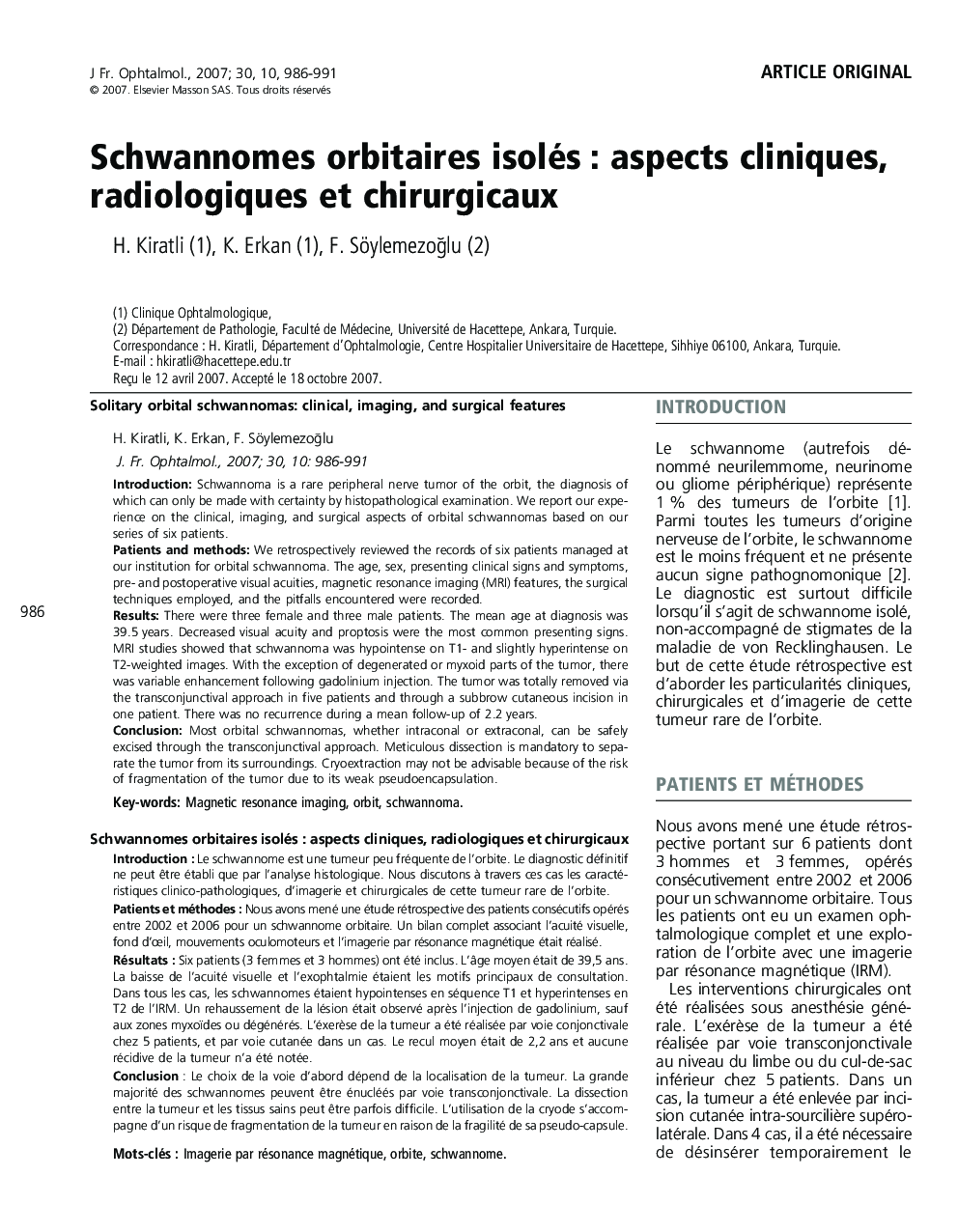| کد مقاله | کد نشریه | سال انتشار | مقاله انگلیسی | نسخه تمام متن |
|---|---|---|---|---|
| 4025603 | 1602769 | 2007 | 6 صفحه PDF | دانلود رایگان |

IntroductionLe schwannome est une tumeur peu fréquente de l'orbite. Le diagnostic définitif ne peut être établi que par l'analyse histologique. Nous discutons à travers ces cas les caractéristiques clinico-pathologiques, d'imagerie et chirurgicales de cette tumeur rare de l'orbite.Patients et méthodesNous avons mené une étude rétrospective des patients consécutifs opérés entre 2002 et 2006 pour un schwannome orbitaire. Un bilan complet associant l'acuité visuelle, fond d'Åil, mouvements oculomoteurs et l'imagerie par résonance magnétique était réalisé.RésultatsSix patients (3 femmes et 3 hommes) ont été inclus. L'âge moyen était de 39,5 ans. La baisse de l'acuité visuelle et l'exophtalmie étaient les motifs principaux de consultation. Dans tous les cas, les schwannomes étaient hypointenses en séquence T1 et hyperintenses en T2 de l'IRM. Un rehaussement de la lésion était observé après l'injection de gadolinium, sauf aux zones myxoïdes ou dégénérés. L'éxerèse de la tumeur a été réalisée par voie conjonctivale chez 5 patients, et par voie cutanée dans un cas. Le recul moyen était de 2,2 ans et aucune récidive de la tumeur n'a été notée.ConclusionLe choix de la voie d'abord dépend de la localisation de la tumeur. La grande majorité des schwannomes peuvent être énucléés par voie transconjonctivale. La dissection entre la tumeur et les tissus sains peut être parfois difficile. L'utilisation de la cryode s'accompagne d'un risque de fragmentation de la tumeur en raison de la fragilité de sa pseudo-capsule.
IntroductionSchwannoma is a rare peripheral nerve tumor of the orbit, the diagnosis of which can only be made with certainty by histopathological examination. We report our experience on the clinical, imaging, and surgical aspects of orbital schwannomas based on our series of six patients.Patients and methodsWe retrospectively reviewed the records of six patients managed at our institution for orbital schwannoma. The age, sex, presenting clinical signs and symptoms, pre- and postoperative visual acuities, magnetic resonance imaging (MRI) features, the surgical techniques employed, and the pitfalls encountered were recorded.ResultsThere were three female and three male patients. The mean age at diagnosis was 39.5 years. Decreased visual acuity and proptosis were the most common presenting signs. MRI studies showed that schwannoma was hypointense on T1- and slightly hyperintense on T2-weighted images. With the exception of degenerated or myxoid parts of the tumor, there was variable enhancement following gadolinium injection. The tumor was totally removed via the transconjunctival approach in five patients and through a subbrow cutaneous incision in one patient. There was no recurrence during a mean follow-up of 2.2 years.ConclusionMost orbital schwannomas, whether intraconal or extraconal, can be safely excised through the transconjunctival approach. Meticulous dissection is mandatory to separate the tumor from its surroundings. Cryoextraction may not be advisable because of the risk of fragmentation of the tumor due to its weak pseudoencapsulation.
Journal: Journal Français d'Ophtalmologie - Volume 30, Issue 10, December 2007, Pages 986-991